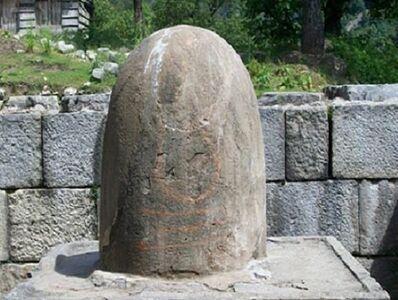During my many sojourns abroad I used to be embarrassed with the question of worship of the Shiva Lingam. I could not answer it to my satisfaction and a lot remained unanswered. I tried my best , and among many a mumble and eating of words explained it as the worship of a form of the God.
Many summers later and after much education I wonder at the thought of the rich imagination the Hindus possess to worship a stone by the way side in which their god resides. I marvel at the flight of their imagination that the creator of this magnificent world lives in that single stone. It is not a form, the stone is the content. Just imagine the power of this imagination. Even to imagine this power it is fathomless.
Shiva is worshiped all over India in the form of a black block of stone known as a Shiva stone. It is a common sight. A black round stone under a tree and it is worshiped. Sometimes a whole temple comes up built around it. Sometimes there is nothing;under the blue sky a single black stone and it moves you to reverence. The devotees can see everything in it . The Lord God,the form and the content, the creator and the destroyer,the ethereal and the sublime.
Many a time I have stood before it in wonder. What power this stone possess to make the literate and the illiterate, the rich and the poor, the believer and the non-believer bow down in obeisance.
A Shiva stone, which is essentially a 'mark' or 'symbol' of Shiva, sometimes appears as an un-worked block of stone, but typically it is represented by a smooth, rounded stone which resembles the Shiva.
It might be embarrassing to many, that the Shiva Linga, not the stone, known as 'pinda'as shown here, consists of two parts: the vertical stone shaft, which may be seen as the male component, Shiva, and the circular horizontal base, called a yoni or pitha which is the female component, Shakti. Together the linga and pitha form the Shiva-Shakti symbol of divine unity. The one who is commonly called "Shiva'' is seen in the linga as both Shiva and Shakti, male and female, divine spirit and divine matter. It is an ariel view from inside of a human, the ‘atma’ of the male and female in union. But that is another story, which I will keep for another day.
The basic concept that a stone can be worshiped as a God is divine. This Shiva stone worship is superior because it makes the worship simple because of the form while maintaining the truth that God is not having any definite form. In Sanskrit, Linga means a 'mark' or a symbol, which points to an inference. Thus the stone is a symbol of Lord Shiva - a mark that reminds of the Omnipotent Lord, which is formless.
This speaks to the devotee in the unmistakable language of silence, and it is only the outward symbol of the formless being, Lord Shiva who is identical with the supreme 'Brahman.'The shape is like an egg, and represents the 'Brahmanda' or the cosmic egg. The Shiva stone is an object of “ultimate power, the power of transmutation that lies dormant within each of us” and is a sacred symbol of divine creation.
The stone is a symbol of the God Shiva, the supreme God of the Hindu pantheon who is formless and omnipresent.

